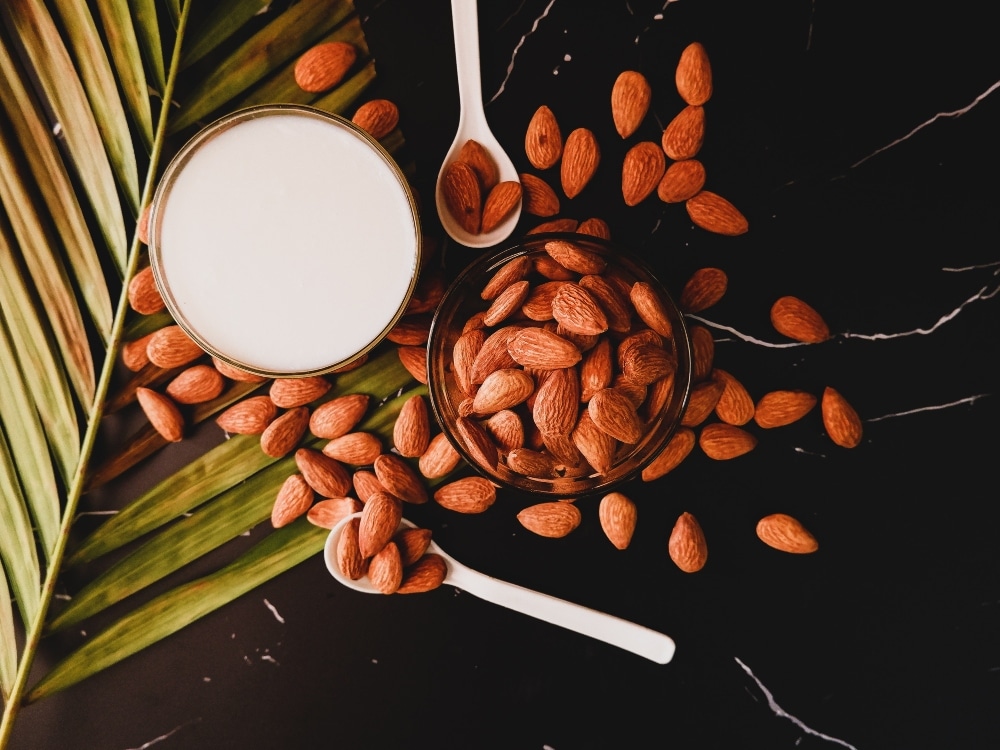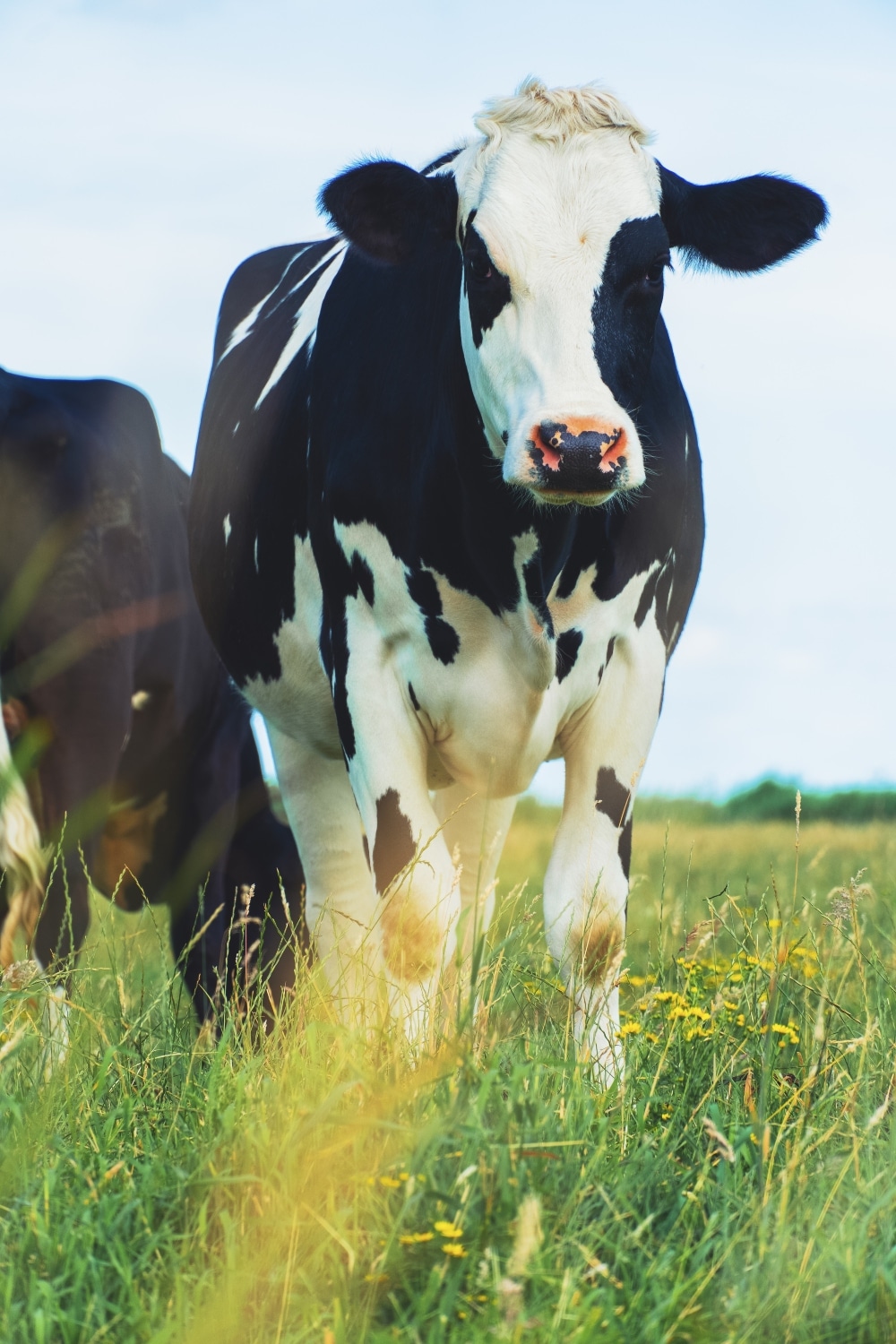From vegnews.com
Actually how bad is almond milk for the environment? It turns out, it’s a complex question
Nowadays, milk can be made out of most plant-based ingredients (that’s not an exaggeration, even potato milk is a thing). And, while cow’s milk used to be most people’s go-to for cereal, coffee, and smoothies, consumers are embracing the vegan milk revolution. In fact, by 2028, the plant-based dairy market is set to exceed $31 billion in value. And in 2020, research revealed that more than 40 percent of Americans regularly purchase vegan milk.
This is all good news for the animals. After all, the dairy industry raises billions of animals, most of whom live in industrialized conditions on factory farms. But is it good news for the planet? Almond milk, in particular, has a bad reputation when it comes to environmental impact. But it’s also one of the most popular milk alternatives on the market. So what do you need to be aware of next time you’re browsing the plant-based milk selection in the grocery store? Should you still grab the almond milk? Let’s dive in.
What is almond milk?
Almond milk features a mix of ground almonds and water. It is thinner and more watery than other plant-based milks on the market (oat milk, for example, is known for being quite thick and creamy), and, as you might expect, it has quite a nutty flavour. The biggest producer of almond milk is California, which is responsible for around 80 percent of the world’s almonds and 100 percent of those exported inside the US.
 Unsplash
Unsplash
Is almond milk bad for the environment?
Over the last few years, almond milk has hit the headlines quite a few times, and not all of the coverage has been positive. Many have questioned whether the plant-based alternative is really that good for the environment, and that’s largely because almonds are a very, very thirsty crop.
Just one small almond, grown in California, has a water footprint of around 3.2 gallons, according to one 2017 study. It sounds like a lot (because it is), but it’s not unusual for nuts to need a lot of water to grow. One pistachio, for example, still needs more than a gallon. But one of the biggest issues with almonds specifically is that they are extremely high in demand, and their production is concentrated in one area: California’s Central Valley. In fact, more than 450,000 acres of the San Joaquin Valley and the Sacramento Valley are dedicated to almond cultivation.
Having such a thirsty crop in one spot in California is tricky because the state is prone to droughts. According to the National Irregated Drought Information System, more than 33 million Californians are currently affected by droughts, and last year was the driest year on record.
So to produce almonds, farmers have no choice but to find other sources of water. Like most trees, they will die without it. But this means that California’s groundwater sources are being depleted, according to World Water Reserve. But it’s difficult to estimate just how bad the problem is. “Groundwater volume is notoriously difficult to estimate,” notes the online resource, which is dedicated to helping people learn about water security. “In theory, California could have plenty of groundwater at its disposal, or it could be on the verge of completely running out.”
Another issue with almond cultivation is its impact on the bees. Almond trees rely on cross-pollination, which requires pollinators, namely bees. But the fertilizer used on the crops is extremely toxic to the insects. “The bees in the almond groves are being exploited and disrespected,” one organic beekeeper, called Patrick Pynes, told The Guardian in 2020. “They are in severe decline because our human relationship to them has become so destructive.”
All of this paints quite a bleak picture of a humble glass of almond milk. But it’s not all bad. When it comes to emissions, this plant-based beverage actually has one of the smallest footprints of the whole alternative milk industry. This is because like all trees, almond trees sequester carbon as they grow. According to the Yale School of the Environment, one kilogram of almonds emits less than one kilogram of carbon emissions.
“Almond orchards capture and store a significant amount of carbon both above and below the surface over their 25-year lifecycle,” said Alissa Kendall, who worked on the research, which was published in Yale’s Journal of Industrial Ecology in 2015. “This carbon storage provides a climate benefit not considered in conventional carbon footprints.”
Dairy and the environment
Almonds have their issues, there is no denying it. But if you choose almond milk over dairy in the grocery store, you’re still making a better choice for the environment. And that’s because all plant-based milks, almond included, are better for the planet than cow’s milk. In fact, according to the biggest one glass of dairy milk produces three times more greenhouse house gasses than any plant-based milk, and requires nine times more land. To sustain one dairy cow for one day, it also takes between 30 to 50 gallons of milk.
In 2018, the biggest-ever food production analysis, conducted at Oxford University, concluded that giving up dairy and meat was the single biggest way a person could reduce their impact on the environment. Doing so would reduce global farmland use by 75 percent.
“A vegan diet is probably the single biggest way to reduce your impact on planet Earth, not just greenhouse gasses, but global acidification, eutrophication, land use, and water use,” lead researcher Joseph Poore told The Guardian at the time. “It is far bigger than cutting down on your flights or buying an electric car.”
“Agriculture is a sector that spans a multitude of environmental problems. Really it is animal products that are responsible for so much of this. Avoiding consumption of animal products delivers far better environmental benefits than trying to purchase sustainable meat and dairy,” he added.
 Unsplash
Unsplash
Can you drink almond milk sustainably?
If you really love almond milk, there are ways to improve your consumption. B Corp certifications, for example, are proof that a brand meets high standards of social and environmental performance. London plant-based milk brand Rude Health—which makes almond milk with nuts sourced from Sicily, not California—is a certified B Corp. Colorado-based vegan milk brand Silk has also received a B Corp certification.
Another option is to rotate the milk you buy, so you’re not opting for almond milk every time. Consider switching up your grocery store shop every few weeks to include oat milk, for example, which requires less water than many other plant-based milks on the market. Soy milk is another option, as it also has a lower water footprint.
But you also don’t have to buy into the almond milk market at all. If you’ve got the time, the energy, and the means, you could source some organic almonds, and make your own almond milk at home. If this sounds appealing, we’ve got the best (and easiest) almond milk recipe here.
https://vegnews.com/vegan-news/is-almond-milk-bad-environment-compare-cow-milk
No comments:
Post a Comment